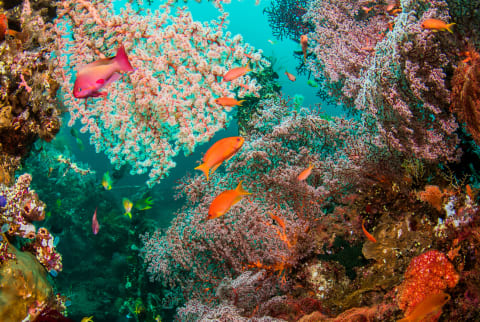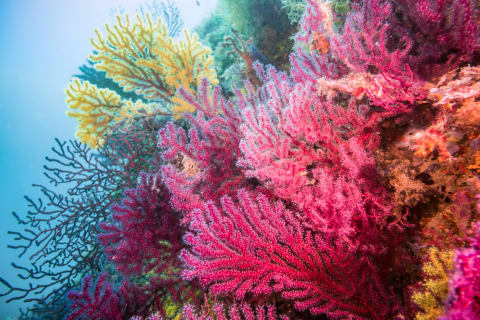Advertisement
The Incredible Ways Scientists Are Rebuilding Our Coral Reefs


This year's extreme storms have further damaged coral reefs—an ecosystem that was in bad shape to begin with. Corals thrive in warm, tropical waters, and even slight shifts in temperature and acidity can throw them off. Though warming oceans have threatened their livelihood for years, 2016 and early 2017 proved an especially warm period, which led to the worst coral bleaching event in recent history. Coral bleaching occurs when the beneficial bacteria that feed corals begin to die off, leaving reefs starving and close to death. Photos of reefs painted white—eerie wastelands void of color and life—have become a rallying cry to the scientific community to band together and buy our reefs more time.
Coaxing coral back to life.
Warmer temperatures, along with overfishing, runoff, and dredging, have now killed off nearly 50 percent of the world's coral reefs. Scientists are warning that reefs could be a thing of the past as soon as 2050.
Reefs are good for a lot more than just a beautiful photograph, and this mass extinction would be felt around the world. Reef tourism has historically brought billions of dollars a year to economies like Australia and Hawaii, and low-lying lands depend on reefs as natural barriers from storm surges. An estimated 500 million to 1 billion people rely on nearby reefs for food, and certain Pacific islands get 70 percent of their protein from them. Once these food sources run dry, the island's inhabitants are forced to move inland, becoming what's known as "ecological refugees."
The first step in nursing these important ecosystems back to health is decreasing the rate of climate change. "There's no scientific doubt that warming oceans are driving these dramatic increases in bleaching events," says Joe Pollock, the coral strategy director for The Nature Conservancy, a green nonprofit. "Slowing the rate of climate change is the single most important thing we can do to not only protect corals but keep systems alive around the world." However, this won't happen overnight, and we need to find a way to nurse coral back to health in the meantime.
One way we can start to do so is with policy. Ecologically protected areas, like the one established by then-president Obama in 2016—a nearly 600,000-square-mile expanse in Hawaii—regulate the amount of fishing that can happen around a reef and therefore increase its chance of survival.
As the oceans continue to warm and coral continues to die off, though, scientists are also banding together to find innovative new ways to take matters into their own hands.
"This is a field that's definitely growing," Pollock says of reef restoration. "People are starting to realize that no coral reefs on the face of the planet are immune to the degradation we are now seeing. What we're doing right now isn't enough."
"It's so depressing to see what's happening in the reefs," says Ruth Gates, Ph.D., previously a professor of ocean science who is now spearheading research on how reefs can survive a warmer future out of the Hawaii Institute of Marine Biology. "Watching their decline has made me think much more comprehensively about how we can take science and use it to solve the problem rather than just monitor it. For me, having an avenue to try things that could help the prognosis is the only way I can live with being a coral biologist at this time."

Letting nature do its thing.
Traditional reef restoration techniques include micro-fragmentation—breaking corals into tiny pieces that can regrow up to 25 times faster than they would otherwise—and propagation—promoting conditions for sexual reproduction in reefs. Pollock's team is now looking into how scientists can scale up these techniques to bring life back to massive ecosystems relatively quickly. Right now, they're focusing on the Caribbean, and the results are promising. He describes a scene out of St. Croix: healthy coral fragments dangling from what look like little pieces of PVC scattered throughout the ocean floor.
"We've been successful in developing technology to essentially be coral farmers. It's great, but it's only part of the solution. The work we're doing now is looking beyond one or two species to a suite of corals that are more representative of what's on the reef. We're using mathematical modeling that shows how patches of reef are connected, so we can target restoration efforts to get healthy coral to where they have the best potential to spread." To do so, they're training local divers, fishers, and volunteers to become involved in reef restoration and monitoring.
Stepping in where necessary.
Over in Hawaii, Dr. Gates' approach is less about setting up the conditions for nature to thrive and more about pinpointing ways science can move the process along. Her lab has started to breed what she refers to as "super coral" that can thrive in a warming world.
"Fifty percent of the world's reef have survived conditions that have killed the other 50 percent. What that tells you is that some corals are actually hardier than others," she explains of her research. "We should start to interfere. We should start breeding coral that we think has the greatest chance of surviving." Like humans, some coral are genetically blessed, so to speak, covered in plant cells that are more tolerant to changing temperatures. Her lab seeks out those healthy, hardy coral and breeds them with others that are too.
She's also looking for ways to transplant the microbiome from healthy coral over to unhealthy ones, in what she likens to a fecal transplant in humans. Lastly, her research is looking into whether immersing coral in a difficult environment can actually make it more resilient in the long-term.
"We know that if coral survive a really bad temperature disturbance, they kind of fix that in their memory as something that they're used to. When they see that same disturbance in the future, it doesn't seem so stressful to them," she says, describing how her team can introduce them into warm, acidic water in a controlled lab setting.
While her research is still in a relatively early phase, it, too, has shown promise over the last two and a half years. Her team has already successfully bred coral, and now they're starting to condition them and experiment with microbiome treatments. Some contest that this more sci-fi-esque approach is unnatural, but Gates says that it's the same type of gene selection we've been doing with our food and pets for years now. And in this case, it's necessary given the ticking clock. "We can train corals to be better. But we have to do this now, and we have to be very proactive."
Both Gates and Pollock are hopeful that advancements in coral science can restore reefs before it's too late.
"We may not have the ultimate solution yet, but when you get lots of people coming to the table with different skill sets, the chances of solving the problem are increased," says Gates. "You have to be optimistic. I think people can solve things. Let's stop worrying about the scale of it and just get started."
Check out what more ocean experts have to say about the future of our planet here.
Watch Next
Enjoy some of our favorite clips from classes
Enjoy some of our favorite clips from classes
What Is Meditation?
Mindfulness/Spirituality | Light Watkins
Box Breathing
Mindfulness/Spirituality | Gwen Dittmar
What Breathwork Can Address
Mindfulness/Spirituality | Gwen Dittmar
The 8 Limbs of Yoga - What is Asana?
Yoga | Caley Alyssa
Two Standing Postures to Open Up Tight Hips
Yoga | Caley Alyssa
How Plants Can Optimize Athletic Performance
Nutrition | Rich Roll
What to Eat Before a Workout
Nutrition | Rich Roll
How Ayurveda Helps Us Navigate Modern Life
Nutrition | Sahara Rose
Messages About Love & Relationships
Love & Relationships | Esther Perel
Love Languages
Love & Relationships | Esther Perel











